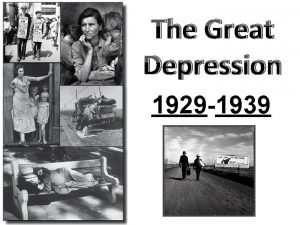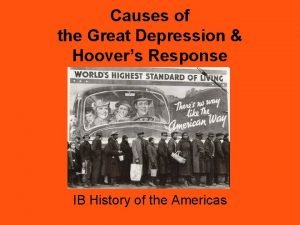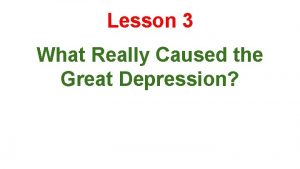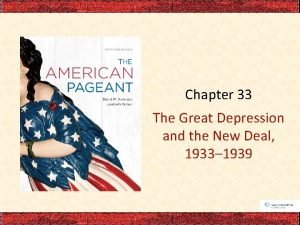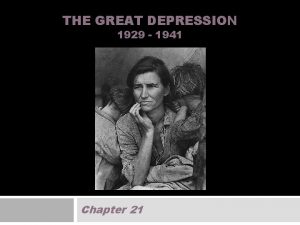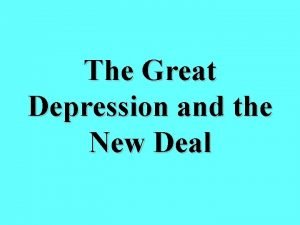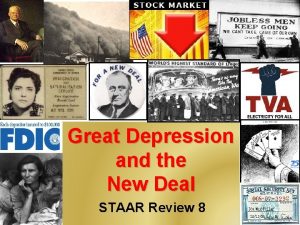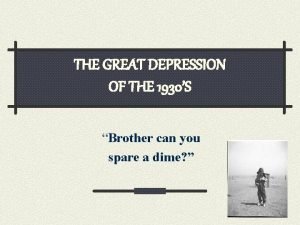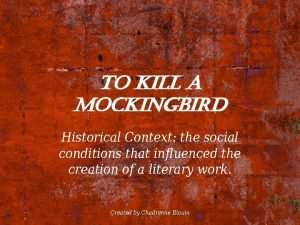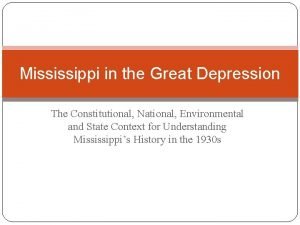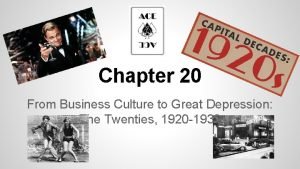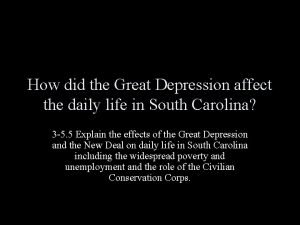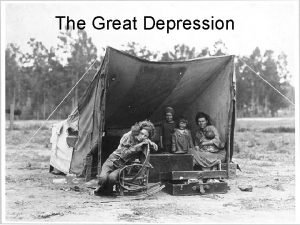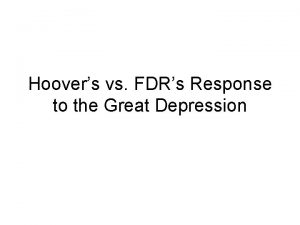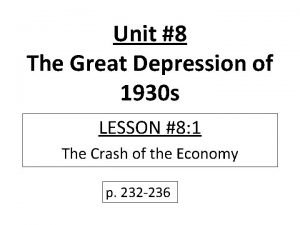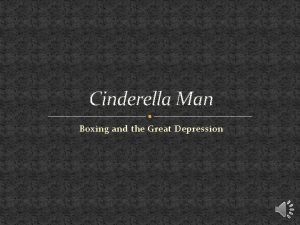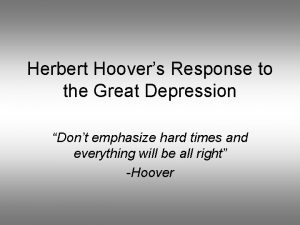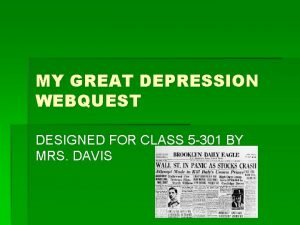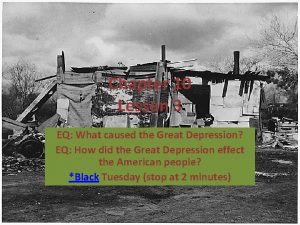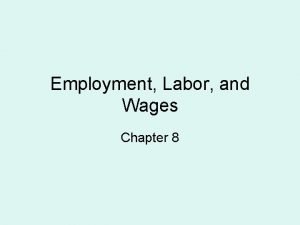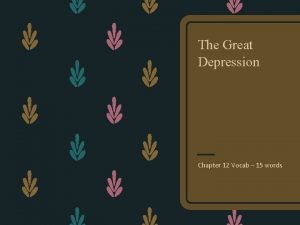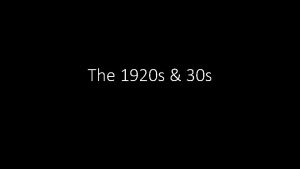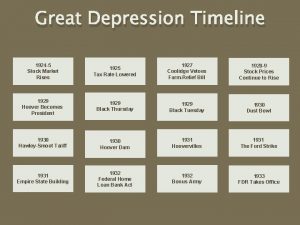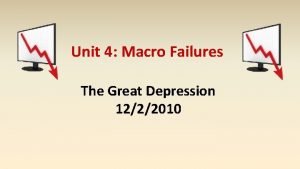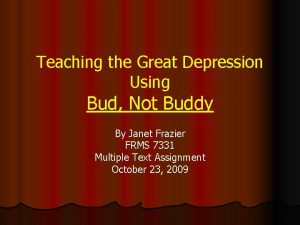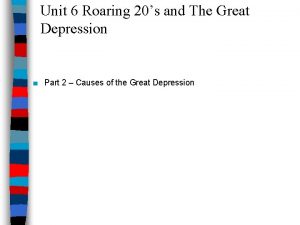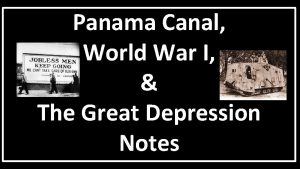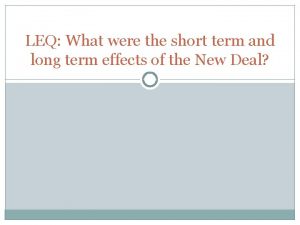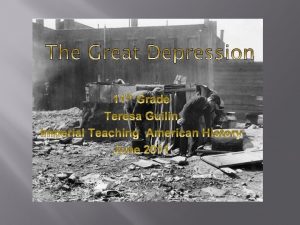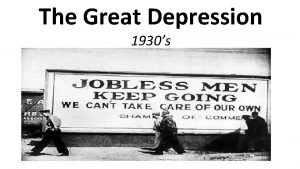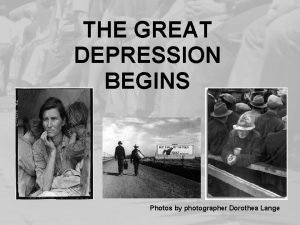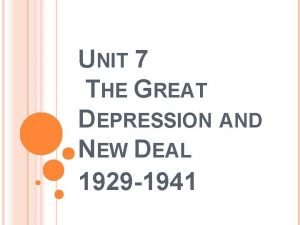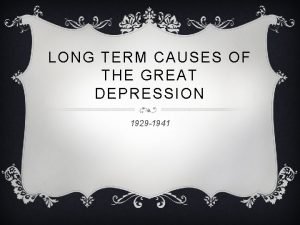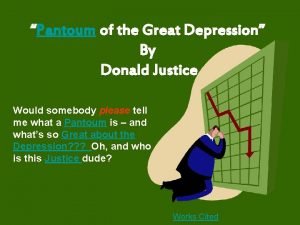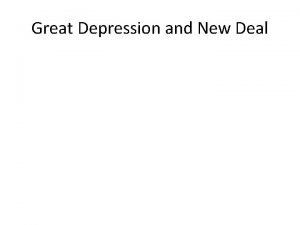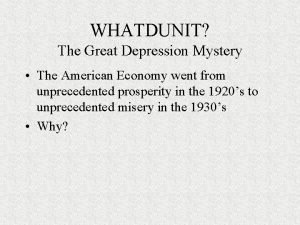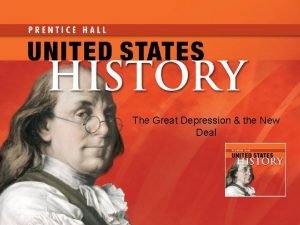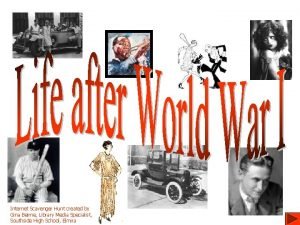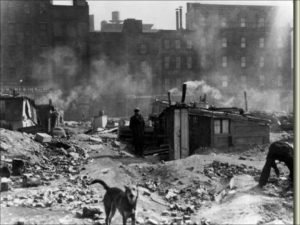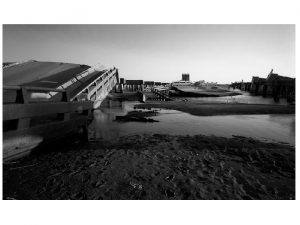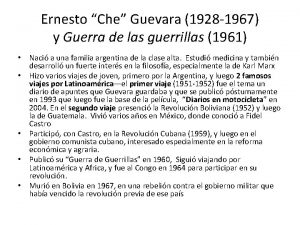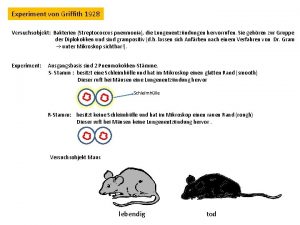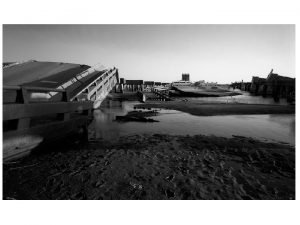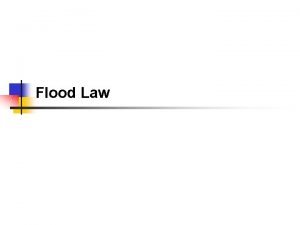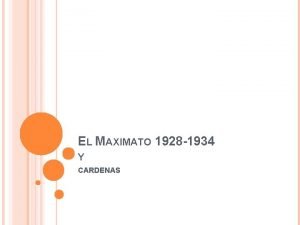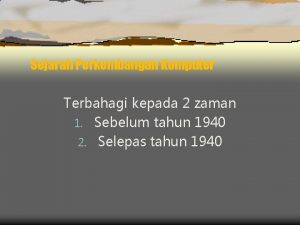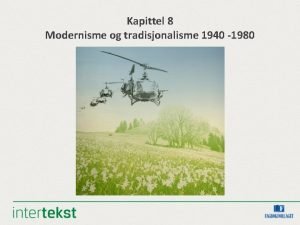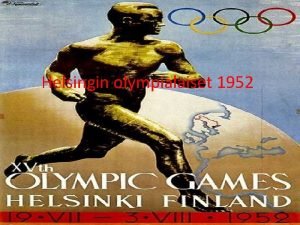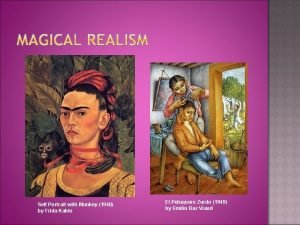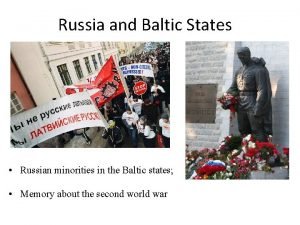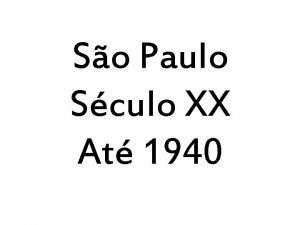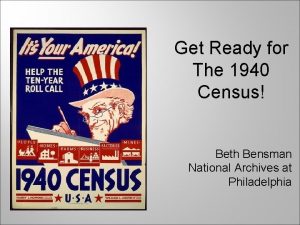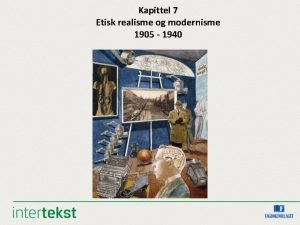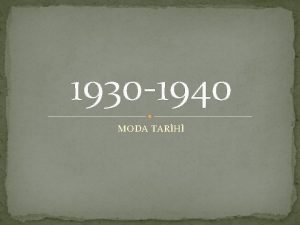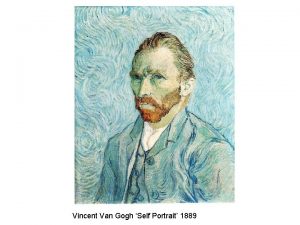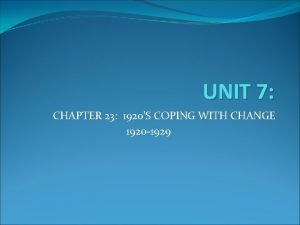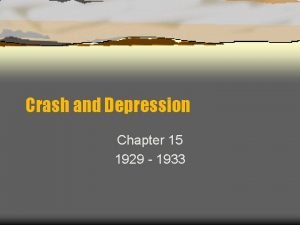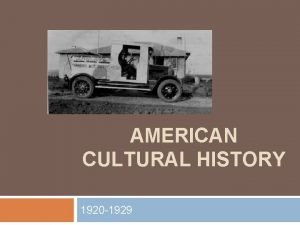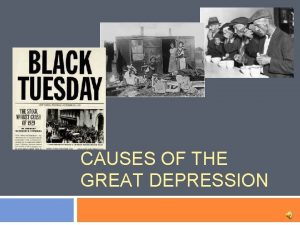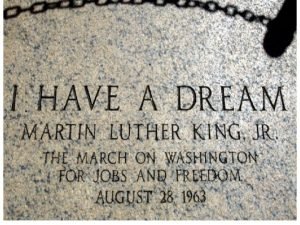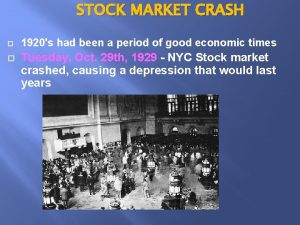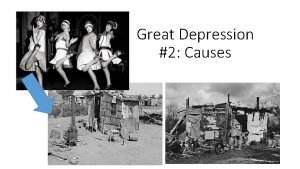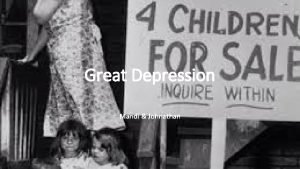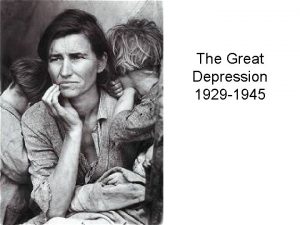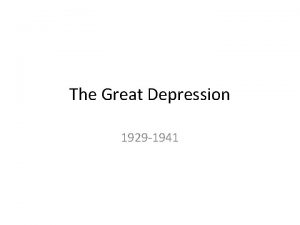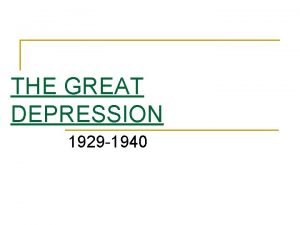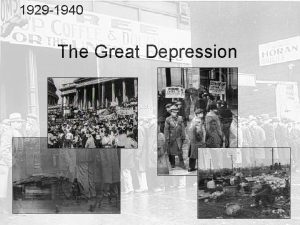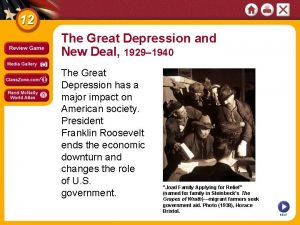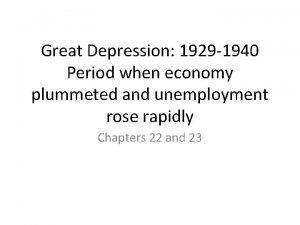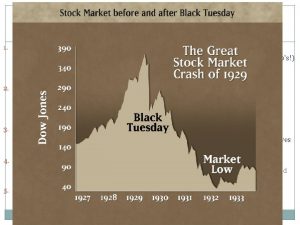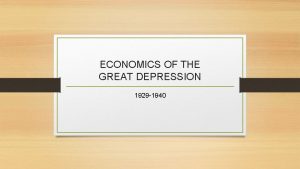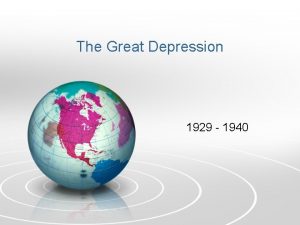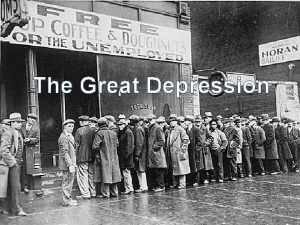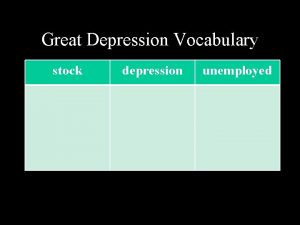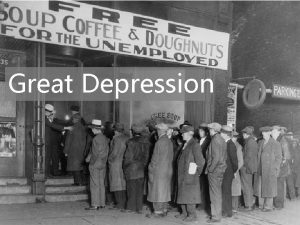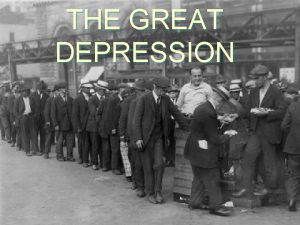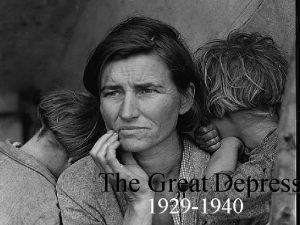The Great Depression 1929 1940 Election of 1928
























































































































- Slides: 120

The Great Depression 1929 -1940

Election of 1928 • The economic collapse that began in 1929 had seemed unimaginable only a year earlier. • The election of 1928 the presidential candidates would paint a picture of the future to be one of prosperity. • Herbert Hoover declared “We are nearer to the final triumph over poverty than ever before in the history of any land. ”

Election of 1928 HOOVER VS. SMITH • When President Calvin Coolidge announces that he won’t run for reelection, the GOP nomination went to Secretary of Commerce Herbert C. Hoover. • The Democrats nominate Governor Alfred E. Smith of New York.

Herbert Hoover seemed to be the ultimate problem-solver. As a mining engineer, he had turned marginal operations into thriving enterprises. During World War I, his administration of European food relief was nothing short of brilliant. As secretary of commerce from 1921 to 1928, he transformed a once-sleepy department into a purposeful information clearinghouse.

Alfred E. Smith • In 1928, Smith was again nominated by Franklin Roosevelt at the Democratic convention and gained an easy first ballot victory. However, Smith’s New York accent, Irish immigrant heritage, Roman Catholicism and ties to big city political machines did not wear well in the South and West. He was soundly defeated by Herbert Hoover and an electorate that equated prosperity with the Republican Party.

Campaign Issues • By 1928 Prohibition had become a major issue among voters. • Hoover who favored the ban on liquor sales was considered a “dry” in the popular language of the day. • Smith on the other who disliked the ban was considered a “wet. ”

Campaign Issues • The candidates religious differences sparked a smear campaign against Smith. • Many Protestants were willing to believe that the Catholic Church financed the Democratic Party and would rule the United States if Smith were elected. • The slurs embarrassed Hoover who was a Quaker and he tried to stop them. • The charges did hurt Smith’s candidacy.

• Smith’s biggest problem however was the prosperity of the 1920 s for which the Republicans took full credit. • The Republicans had promised to continue the trend with such slogans as “two cars in every garage. ” • Hoover would receive over 6 million more votes than Smith and won the Electoral College in a landslide 444 to 87.

What campaign issues led to Herbert Hoover's election to the presidency? • Prohibition • Religious Values • Economic prosperity

The Long Bull Market • The wave of optimism that swept Hoover into the White House also drove stock prices to ne highs. • The stock market was established as a system for buying as selling shares of companies. • Sometimes circumstances in the stock market lead to a long period of rising stock prices known as a bull market.

• In the late 1920 s a prolonged bull market convinced many Americans to invest heavily in stocks. • By 1929 3 to 4 million Americans or roughly 10% of the households owned stocks. • As the market continued to soar many investors began buying stocks on margin they made only a small cash down payment. • The stock had become the most widely visible symbol of a prosperous American economy. • Then as now the Dow Jones Industrial Average was the most widely used barometer of the stock market’s health.

• With a $1000 an investor could buy $10, 000 worth of stocks. • The other $9000 would come as a loan from a stockbroker who earned both a commission on the sale and interest on the loan. • The broker held the stock as collateral. • As long as stock prices kept rising buying on margin was safe. • To protect the loan the broker could issue a margin call demanding the investor repay the loan at once. • Buyers hoping to make a fortune overnight engaged in speculation.

What was the stock market like in the 1920 s? • A bull market with a long period of rising stock prices.

Great Crash • By late 1929 a lack of new investors in the stock market caused stock prices to drop caused the bull market to end. • As stockbrokers advised their customers of margin calls, customers responded by placing their stocks up for sale, causing the stock market to plummet further. • Stock prices fell drastically on October 29, 1929, BLACK TUESDAY resulting in a $10 to $15 billion loss in value.

• Why this did not cause the Great Depression it did undermine the economy’s ability to hold out against its other weaknesses. • The stock market crash weakened the nation’s bank. • Banks lost money on their investments and speculators defaulted on loans. • Because the government did not insure bank deposits customers lost their money if a bank closed. • Many bank customers withdrew their money at the same time causing the bank to collapse.

Causes of the Depression • Overproduction and low demand leads to employee layoffs. • Low wages reduce consumer buying power. • High tariffs restrict foreign demand for American goods. • Unemployment reduces buying power further.

How did bank failures contribute to the Great Depression? • The failures triggered a crisis of confidence in the banking system. • People made runs to banks causing them to collapse. (withdrawing all their money at one time, usually for fear the bank is going to collapse. )

Roots of the Great Depression • Most economists agree that overproduction was a key cause of the Depression. • Most Americans did not earn enough to buy up the flood of goods they helped to produce. • In 1929 the top 5% of American households earned 30% of the country’s income. • More than 2/3’s of the nation’s families earned less than $2500 a year.

• During the 1920 s many Americans bought high cost items such as refrigerators and cars on installment plans which they would make a small down payment and pay the rest in monthly installments. • The Hawley-Smoot Tariff intensified the Depression by raising the tax on imports Americans purchased less from abroad because of the high cost. • In return foreign countries raised their tariffs on American products causing fewer to be sold overseas.

How did the decline in worldwide trade contribute to the Depression? • Tariffs damaged American sales abroad and discouraged imports.

Depression Worsens • In 1931 to make money, large numbers of unemployed people began to sell apples on the streets of major cities. • Selling apples became a popular symbol of the Depression years. 2

Depression Worsens • In 1930 over 1, 352 banks suspended operations across the nation more than twice the number of bank failures in 1929. • The Depression grew worse during Hoover’s administration. • By 1933 more than 9, 000 banks failed. More than 30, 000 companies went out of business.

Soup Kitchens • People without jobs often went hungry. • Whenever possible they joined bread lines to receive a free handout of food or lined up outside soup kitchens which private charities set up to give poor people a meal at no cost or low cost food.

Living in Makeshift Villages • Families or individuals who could not pay their rent or mortgage lost their homes. • Landlords would ask the courts for an eviction notice. • Court officers called bailiffs then ejected the nonpaying tenants piling their belongings in the street.

• Throughout the country newly homeless people put up shacks on unused or public lands forming communities called shantytowns. • Blaming the president for their plight people referred to such places as Hoovervilles.

• In search of work or a better life, many homeless and unemployed Americans began to wander around the country walking, hitchhiking or often riding the rails. • These wanderers called hobos would sneak past railroad police to slip into open boxcars on freight trains for a ride to somewhere.

• Hobos camped in what was known as “hobo jungles” usually situated near rail yards. • Hundreds of thousands of people mostly boys and young men wandered from place to place in this fashion.


Dust Bowl • Farmers soon faced a new disaster since the beginnings of homesteading on the Great Plains farmers had gambled with nature. • As crop prices dropped in the 1920 s many American farmers left their fields uncultivated. • A terrible drought in the Great Plains beginning in 1932 caused the region to become a Dust Bowl. (from Dakotas to Texas)


• Many Midwestern farmers and Great Plains farmers lost their farms. • Many families moved west to California hoping to find a better life but most still faced poverty. • Winds whipped the arid earth blowing it aloft and blackening the sky for hundreds of miles. • It buried livestock and crops and piled up against houses like snow. By 1937 yearly dust storms were about 72.


What chain of events turned the once fertile Great Plains into the Dust Bowl? • Uprooting the wild grasses • A drop in crop prices • Drought

Escaping the Depression • Americans escaped the hardships of the Depression by going to the movies and listening to radio broadcasts. • Stories tended to be about overcoming hardships and achieving success.

• Walt Disney produced the first feature length animated film, Snow White and the Seven Dwarfs, in 1937. • Other films like The Wizard of Oz, Mr. Smith Goes to Washington, and Gone with the Wind contained stories of triumph over adversity and visions of a better life.

• Families gathered around the radio daily to hear news or listen to comedy shows like George Burns or dramatic series like the Lone Ranger. • Melodramas called soap operas became very popular with housewives. • Soap operas received their name because makers of laundry soaps often sponsored them.

What movies and radio shows entertained Americans during the Depression? • Comedies • Westerns • Soap Operas

• Americans also used radio and motion pictures as ways to forget about the Depression.

Depression in Art • Homeless and unemployed Americans were the subjects of art and literature during the 1930 s. • Artist and writers tried to capture the real life drama of the Depression. • Thomas Hart Benton and Grant Wood emphasized traditional American values in their art.

Grant Wood’s Painting American Gothic Wood’s most famous painting.

Thomas Hart Benton’s Paintings

• John Steinbeck’s 1939 novel The Grapes of Wrath told the story of an Oklahoma family fleeing the Dust Bowl to find new life in California. • Steinbeck like many writers of the time wrote of poverty, misfortune and social injustice.

• William Faulkner’s literary technique stream of consciousness, revealed characters’ thoughts and feelings before they spokethoughts they dared not reveal. The Sound and the Fury is his best example. • In his novels he exposed hidden attitudes of Southern whites and African Americans in a fictional Mississippi county.

• Photojournalist Margaret Bourke-White’s striking pictures displayed in Fortune magazine showed the ravages of drought. • She photographed homeless people and uncovered the desperation of her subjects.


• In the 1930 s Life was a popular and powerful magazine because it provided a commentary on American Life.

Promoting Recovery • During the Depression homeless Americans blamed President Hoover for their situations. • Many homeless people wrapped themselves in used newspapers they called “Hoover blankets” to keep themselves warm. • Some wore their empty pockets inside out and called them “Hoover Flags. ” 3

• On Friday October 25, the day after Black Thursday, President Hoover issued a statement assuring the nation that industry was “on a sound and prosperous basis. ” • In March 1930 he told the public that “the worst effects of the crash will have passed during the next 60 days. ”

• In an effort to promote economic recovery, President Hoover held a series of conferences bringing together the heads of banks, railroads, big business, labor and government. • Hoover received a pledge from industry to keep factories open and stop cutting wages. • After the pledge failed, Hoover increased public works a government financed building project.

• Hoover asked the nation’s governors and mayors to increase public works spending. • At the same time however, Hoover refused to increase government spending or taxes. • He feared that deficit spending would actually delay an economic recovery. • Americans blamed the Republican Party for the Depression. • As a result in the midterm elections of 1930 the Republicans lost 49 seats and their majority in the House of Representatives.

Why did Hoover oppose deficit spending? • He believed it would delay an economic recovery.

Pumping Money into the Economy • Hoover soon turned his attention to the problem of money. • The government he believed had to make sure that banks could make loans to corporations so they could expand production and rehire workers.

• The president asked the Federal Reserve Board to put more currency into circulation but the Board refused. • In 1931 Hoover set up the National Credit Corporation to create a pool of money to enable troubled banks to continue lending money in their communities but this wasn’t enough. • By 1932 Hoover felt the government had to provide funding for borrowers.

• He asked Congress to set up the Reconstruction Finance Corporation (RFC) to make loans to banks and railroads and agricultural institutions. • The economy continued to decline when the RFC was too cautious in its loan amounts.

• Hoover from the start opposed the federal government’s participation in relief- money that went directly to very poor families. • Hoover felt relief was the responsibility of state and local governments. • In 1932 political support was building for a relief measure and Congress passed the Emergency Relief and Construction Act. • The new act called for $1. 5 billion for public works and $300 million in loans to the states for direct relief. • By this time however the new program could not reverse the accelerating collapse.

Why did Hoover oppose the federal government’s participation in relief programs? • Hoover felt that only state and local governments should give out relief.

In an Angry Mood • By 1931 discontentment over the economy led to violence. • Looting, rallies, and hunger marches began. • During a hunger march at the nation’s capital. Police denied protestors food, water, and medical treatment.

• Congress intervened stressing the marchers’ right to petition their government. • Congress permitted them to march on to Capital Hill.

• After the war prices sank so low that farmers could not even earn back their costs let alone make a profit. • Between 1930 and 1934 creditors foreclosed or took possession of almost a million farms.

• In the summer of 1932 farmers also took matters into their own hands. • Beginning in the boom days of WWI many farmers had heavily mortgaged their land to pay for seed, feed, and equipment.

• Some farmers destroyed their crops hoping the reduction in supply would causes the prices to go up. • In Nebraska grain growers burned corn to heat their homes. • In Iowa farmers prevented the delivery of vegetables to distributors. • Georgia dairy farmers blocked highways and stopped milk trucks emptying milk cans into ditches.

• In 1924 Congress enacted a $1000 bonus to be paid to veterans in 1945. • In 1931 a bill was introduced in the house that authorized early payment of the bonus.

• In 1932 the “Bonus Army” marched to Washington, D. C. to ask Congress to approve the legislation. • Once in Washington the marchers camped in Hoovervilles. Hand painted sign on Bonus Army truck states: "We Done a Good Job in France, Now You Do a Good Job in America"


• After Hoover refused to meet with the Bonus Army and the Senate voted the new bonus bill down some of the marchers left. • Some marchers stayed and moved into deserted buildings in Washington D. C. • When Hoover ordered the buildings cleared. Army chief of staff Douglas Mac. Arthur to aide in removing the veterans from the buildings. He refused to follow the orders.

• Some of the marchers left but many stayed and the result was disputes with police and later the Army resulting in several deaths. • Tear gas even killed a baby boy. • Bonus Marchers and the lingering Depression would shape the public’s perception of President Hoover.


The most significant thing that happened in 1929 was what? • Great Depression • Reaction to the Depression also included; • Hunger marches. • Farmer revolts • Bonus Army Marches.

In 1932 who would become president? • Franklin D. Roosevelt

Test Review

Republican _____ declared, “We are nearer to the final triumph over poverty than ever before in the history of any land. ” • Herbert Hoover

The Democrats chose to run for president in 1928 was _____. • Alfred E. Smith

By 1928 ____ had become a major issue among voters. • Prohibition

Hoover was considered a _____ in the popular language of the day. • dry

Many thought the _____ financed the Democratic Party and would rule the United States if Smith got into the White House. • Catholic Church

Hoover won the election over Smith with a landslide of _____ to ___ in the Elector College • 444/87

What campaign issues led to Hebert Hoover’s election to the presidency. • Prohibition, religious values, economic prosperity

A long period of rising stock prices is known as _____. bull market

__ is buying stock by paying only a fraction of the stock price and borrowing the rest. • margin

Buyers hoping to make a fortune overnight engaged in ____. • speculation

What was the stock market like in the 1920 s? • bull market

What were the causes of the Great Depression? • Overproduction, lower wages, high tariffs

October 24 was called ______ the day the stock market plummeted further. • Black Thursday

How did bank failures contribute to the Great Depression? • bank failures triggered a crisis of confidence in the banking system

What chain of events turned the once fertile Great Plains into the Dust Bowl. • uprooting the wild grasses, drought, and uncultivated land

Who would become president after Herbert Hoover? • Franklin D. Roosevelt

Why did Hoover oppose the federal government’s participation in relief programs? • felt that only state and city governments should give out relief

What was significant about the year 1929? • Depression

____ was Grant Wood’s most famous painting • American Gothic

In what ways did people seek to forget about the Depression? • looked to radio and motion pictures

Why was Life magazine so popular during the 1930 s? • its photos provided a powerful commentary on American life

Thomas Hart Benton and _____ led the regionalist school which emphasized traditional American values, especially those of the rural Midwest and South. • Grant Wood

What movies and radio shows entertained Americans during the Depression. • Comedies, westerners, and soap operas

____ produced the first featurelength animated film in 1937. • Walt Disney

From the Dakotas to Texas, America’s pastures and wheat fields became a vast ___. • dust bowl

Many of the homeless unemployed Americans began to wander around the country hitchhiking or most often riding trains they became known as ______. hobos

Throughout the country newly homeless people put up shacks on unused or public lands forming communities called ____. • shantytowns

People often went hungry during the Depression many joined bread lines to receive a free handout or food or lined up outside ______ which private charities set up to give poor people a meal. • soup kitchens

The average family income dropped from $2300 in 1929 to ____ just three years later. • $1600

The ___ grew steadily worse during Hoover’s administration. • Depression

___ would be the head of the Republican ticket in 1928 when Calvin Coolidge decided not to run. • Herbert Hoover

How did the decline in worldwide trade contribute to the Depression? • tariffs damaged American sales abroad and discouraged imports

The ___ aimed to protect American manufacturers from foreign competition but it damaged American sales abroad. • Hawley-Smoot Tariff

To protect the loan a broker could issue ____ demanding the investor repay the loan at once. • margin call

During the 1920 s many Americans bought high cost items on the _____ under which they would make a small down payment and pay the rest in monthly installments. • installment plans

Most economists agree that ______ was the key cause of the Depression • overproduction

___ wrote The Grapes of Wrath published in 1939 tells the story of an Oklahoma family fleeing the Dust Bowl to find a new life in California. • John Steinbeck

In The Sound and the Fury written by _______ shows what his characters are thinking and feeling before they speak. • William Faulkner

_____ photographed homeless people and uncovered the desperation of her subjects. • Margaret Bourke White

The _____ was established as a system for buying and selling shares of companies. • stock market

Hoover’s government-financed building projects were called what? • public works

Why did Hoover oppose deficit spending? • believed it would delay an economic recovery

In 1932 a wealthy woman nicknamed the ______ set up a breadline in San Francisco. • White Angel

In 1931 Hoover set up the _____ to create a pool of money to enable troubled banks to continue lending money in their communities • National Credit Corporation

On October 29, 1929 was dubbed ______when prices on the stock market took the steepest dive. • Black Tuesday

Hoover requested Congress to set up the ____ to make loans to banks, railroads, and agricultural institutions. • Reconstruction Finance Corporation

Hoover strongly opposed the federal government’s participation in ____ money that went directly to impoverished families. • relief

Between 1930 and 1934 creditors ____ on nearly one million farms possession of them and evicting the families. • foreclosed

Veterans who marched on Washington wearing ragged military uniforms and singing old war songs were called ___ by the press. • Bonus Army

_____ was the Army Chief of Staff who ignored Hoover’s order to clear the unoccupied buildings that veterans were living in. • Douglas Mac. Arthur
 Rrr great depression
Rrr great depression Stock market crash political cartoon
Stock market crash political cartoon Black tuesday political cartoon
Black tuesday political cartoon What was hoover's response to the great depression
What was hoover's response to the great depression Great depression political cartoons
Great depression political cartoons How did the great depression impact the world
How did the great depression impact the world Lesson 3 effects of the great depression
Lesson 3 effects of the great depression Chapter 33 the great depression and the new deal
Chapter 33 the great depression and the new deal Http://www.history.com/topics/great-depression
Http://www.history.com/topics/great-depression Great depression vocabulary
Great depression vocabulary What does aaa stand for great depression
What does aaa stand for great depression Brief summary of the great depression
Brief summary of the great depression Dust bowl map activity
Dust bowl map activity Cpi during the great depression
Cpi during the great depression Social context of to kill a mockingbird
Social context of to kill a mockingbird Great depression
Great depression The great depression summary
The great depression summary New woman
New woman Great depression vocab
Great depression vocab Foreclosure great depression
Foreclosure great depression Ww1 to great depression cloze notes
Ww1 to great depression cloze notes The great depression outline
The great depression outline How did the great depression affect daily life
How did the great depression affect daily life Great depression
Great depression Main idea
Main idea Pros and cons of the great depression
Pros and cons of the great depression Great depression ap world history definition
Great depression ap world history definition Hoover v. fdr responses to the great depression
Hoover v. fdr responses to the great depression Rarig great depression
Rarig great depression During the great depression there were many wanderers
During the great depression there were many wanderers Hoovervilles
Hoovervilles High tariffs great depression
High tariffs great depression Okies great depression
Okies great depression Hoovers response to the great depression
Hoovers response to the great depression Great depression webquest
Great depression webquest Dust bowl acrostic poem
Dust bowl acrostic poem During the great depression union promoters
During the great depression union promoters Great depression vocabulary words
Great depression vocabulary words Five effects of the great depression
Five effects of the great depression Hawley-smoot tariff great depression
Hawley-smoot tariff great depression Great depression diary entry
Great depression diary entry Great depression timeline
Great depression timeline Hoover's poor farm tobacco fund
Hoover's poor farm tobacco fund Great depression
Great depression Great depression jeopardy
Great depression jeopardy Bud not buddy
Bud not buddy Laissez faire great depression
Laissez faire great depression Birth rate during the great depression
Birth rate during the great depression Great depression
Great depression What was the great depression
What was the great depression The great depression leq
The great depression leq Great depression photographer
Great depression photographer Great depression
Great depression Hoovervilles great depression
Hoovervilles great depression Describe the human toll of the great depression
Describe the human toll of the great depression Great depression
Great depression Five effects of the great depression
Five effects of the great depression The great depression lesson 2 hardship and suffering
The great depression lesson 2 hardship and suffering New deal
New deal Great depression causes
Great depression causes What were the long term causes of the great depression
What were the long term causes of the great depression Great depression
Great depression Chapter 22 the great depression begins
Chapter 22 the great depression begins Compare and contrast hoover and fdr
Compare and contrast hoover and fdr Donald justice pantoum of the great depression
Donald justice pantoum of the great depression Laissez faire great depression
Laissez faire great depression Overspeculation great depression
Overspeculation great depression The ingenious quarterback
The ingenious quarterback Great depression vocabulary jeopardy
Great depression vocabulary jeopardy Roaring twenties scavenger hunt answers
Roaring twenties scavenger hunt answers What was hoover's response to the great depression
What was hoover's response to the great depression Flood control act
Flood control act 1928 griffith
1928 griffith 1928 magnetic tape
1928 magnetic tape Ernesto catena wikipedia
Ernesto catena wikipedia Definition of pakistan studies
Definition of pakistan studies Uiniti
Uiniti 1928 flood control act
1928 flood control act Griffith experiment
Griffith experiment Flood control act of 1928
Flood control act of 1928 Flood control act of 1928
Flood control act of 1928 Ariel 1928
Ariel 1928 Monomer of dna
Monomer of dna Que fue el maximato
Que fue el maximato Sejarah komputer sebelum 1940
Sejarah komputer sebelum 1940 Computers in 1940
Computers in 1940 Tradisjonalisme
Tradisjonalisme Suomen olympialaiset 1940
Suomen olympialaiset 1940 Self portrait with monkey
Self portrait with monkey Tom és jerry 2021 teljes film magyarul videa
Tom és jerry 2021 teljes film magyarul videa 1925-1940
1925-1940 Baltic states 1940
Baltic states 1940 Ve day times square
Ve day times square Camaro 1940
Camaro 1940 Introduction of nursing research
Introduction of nursing research 1940 census.archives.gov
1940 census.archives.gov Que es una computadora
Que es una computadora Pengertian etika komputer
Pengertian etika komputer 1930-1939 fashion
1930-1939 fashion Acts
Acts Modernisme 1905
Modernisme 1905 Kallocain sammanfattning kapitel 1
Kallocain sammanfattning kapitel 1 1940 moda
1940 moda Evolusi komputer
Evolusi komputer Conclusion of lahore resolution
Conclusion of lahore resolution Sumbangan mohammad eunos abdullah sejarah
Sumbangan mohammad eunos abdullah sejarah Glass spinning top
Glass spinning top Regla de erwin chargaff 1940
Regla de erwin chargaff 1940 Picasso self portrait
Picasso self portrait 2010-1950
2010-1950 1940s computer
1940s computer Chapter 23 activity: coping with change, 1920-1929
Chapter 23 activity: coping with change, 1920-1929 Chapter 15 crash and depression
Chapter 15 crash and depression 1929 trivia
1929 trivia Ruhrkampf ursachen
Ruhrkampf ursachen What severely dampened commerce
What severely dampened commerce King naci
King naci Deadly wound healed 1929
Deadly wound healed 1929 Fun facts about the stock market crash of 1929
Fun facts about the stock market crash of 1929 Ciam arquitetura
Ciam arquitetura 1929
1929
